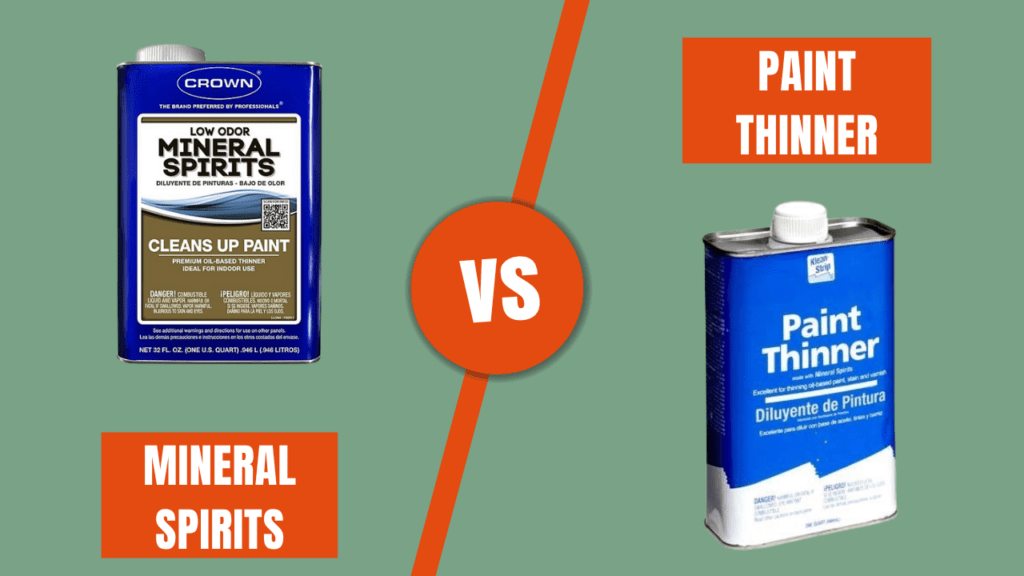
You may have heard of paint thinner and mineral spirits when doing house repairs, art projects, or just painting in general. People often use these two things as if they were the same thing, but are they really?
Let’s look at the differences between paint thinner and mineral spirits so you can choose the right one for your project.
What is Mineral Spirits?
White spirits, or mineral spirits, are a kind of solvent made from petroleum. They are mostly used to clean brushes, thin paints, and get rid of stains that are greasy, tarry, or oily. Painters and artists often use mineral spirits because they don’t smell too bad and work well for cleaning.
Key Characteristics of Mineral Spirits
Composition: 100% petroleum distillates, highly refined
Odor: Mild, less pungent than other solvents
Evaporation Rate: Slower, allowing for a smoother paint finish
Toxicity: Lower than many other paint thinners
Cost: Typically $20–$25 per gallon
What Is Paint Thinner ?
Paint thinner is a term that refers to any solvent that thins paint or cleans up after painting. It can refer to a wide range of products, like mineral spirits, turpentine, acetone, naphtha, and more. Paint thinners are usually less refined than mineral spirits, may contain additives, and have a stronger smell and more volatile nature.
Key Characteristics of Paint Thinner
Composition: Can have mineral spirits in it, but it can also have other solvents and additions.
Odor: Stronger, more pungent due to aromatic compounds
Evaporation Rate: Faster, which can lead to brush marks if not managed
Toxicity: Generally higher, with more volatile organic compounds (VOCs)
Cost: Typically $15–$20 per gallon
Side-by-Side Comparison
| Feature | Mineral Spirits | Paint Thinner |
| Composition | Pure petroleum distillate | Mix of solvents (may include additives) |
| Odor | Mild, less offensive | Strong, pungent |
| Evaporation Rate | Slower | Faster |
| Toxicity | Lower | Higher |
| Cost (per gallon) | $20–$25 | $15–$20 |
| Best Use | Fine finishes, indoor, delicate cleaning | Heavy-duty cleaning, outdoor, dried paint removal |
| Refinement | Highly refined | Less refined |
Also read:
Paint Thinner Hacks Every DIYer Should Know!
Uses and Applications
Mineral Spirits
Thinning Oil-Based Paints & Varnishes: Provides a smooth, even finish without affecting the drying times.
Cleaning Brushes and Tools: Effective for removing fresh oil-based paint.
Degreasing Surfaces: It is ideal for cleaning metal, wood, and other surfaces before painting.
Delicate Projects: Preferred for fine art, woodworking, and indoor projects due to lower odor and toxicity.
Paint Thinner
Thinning Paints: Suitable for thinning oil-based and some latex-based paints (check manufacturer’s instructions).
Heavy-Duty Cleaning: Removes dried paint from brushes, rollers, and surfaces.
Industrial Applications: Used in large-scale cleaning and degreasing, especially outdoors.
Quick Jobs: Faster evaporation makes it suitable for projects where drying speed is important, but can lead to uneven finishes if not applied carefully.
Also read:
Mastering Wood Staining: Essential Do’s and Don’ts
Which One to Use for Different Jobs?
When to Choose Mineral Spirits
Painting and Arts: Mineral spirits are ideal for thinning oil paints and cleaning brushes used with oil-based paints.
Light Cleaning: Best for removing smudges and stains from surfaces without being too harsh.
Indoor Use: Because of its mild odor, mineral spirits are more comfortable to use indoors.
When to Choose Paint Thinner
Heavy-Duty Cleaning: Paint thinner is more effective for removing thick layers of old paint, adhesives, or tar.
Outdoors or Well-Ventilated Areas: The stronger fumes make it better suited for outdoor work or in areas with proper ventilation.
Tougher Jobs: If you’re dealing with really stubborn paint or grime, paint thinner may be the best option.
Effectiveness in Cleaning and Removing Paint
Both solvents are effective at cleaning tools and removing paint, but they do so in different ways:
Cleaning Brushes and Tools
Mineral Spirits: Excellent for cleaning brushes after using oil-based paints, leaving them in good condition.
Paint Thinner: Also effective but more likely to cause wear and tear on delicate brushes.
Paint Removal
Mineral Spirits: Works best for lighter cleaning and removing fresh paint.
Paint Thinner: More effective on dried or thick layers of paint.
Safety and Environmental Considerations
Both mineral spirits and paint thinners are flammable and can be hazardous if mishandled. However, mineral spirits are generally considered safer due to their lower VOC content and less aggressive chemical profile.
Safety Tips
Ventilation: To avoid breathing in fumes, always use in places with good air flow.
Wear gloves, goggles, and a respirator if you need to.
Fire Safety: Stay away from fires and things that create heat.
Disposal: Never toss it away in the garbage or down the drain. Bring it to a place that deals with hazardous trash.
Health Risks
Inhalation: Can cause dizziness, headaches, and respiratory issues.
Skin Contact: May lead to irritation or dermatitis.
Ingestion: Highly toxic—seek immediate medical help if ingested.
Varathane vs. Minwax: Which Wood Finish Brand Should You Choose?
Which One is Better for DIY Projects ?
If you’re a DIY enthusiast, then here’s a quick breakdown:
Mineral Spirits: Ideal for smaller projects, cleaning brushes, and working indoors.
Paint Thinner: Best for larger projects or tougher paint removal tasks.
If you’re a beginner, mineral spirits might be the better choice due to its ease of use and lower odor.
Quick Reference Table
| Use Case | Mineral Spirits | Paint Thinner |
| Thinning oil-based paint | Yes | Yes |
| Fine art/woodworking | Yes | No |
| Heavy-duty cleaning | No | Yes |
| Indoor use | Yes | No (unless ventilated) |
| Removing dried paint | No | Yes |
| Lower odor | Yes | No |
| Lower toxicity | Yes | No |
Remember: Always read product labels and follow manufacturer’s guidelines for the safest and most effective use.
Frequently Asked Questions
1. Can mineral spirits be used in place of paint thinner?
Yes, in most cases, but mineral spirits are milder. They might not be effective for tougher tasks like removing heavy paint layers.
2. Is paint thinner stronger than mineral spirits?
Yes, paint thinner is generally stronger and more aggressive. It’s better suited for tough paint removal.
3. Can both be used for cleaning oil-based paints?
Yes, both solvents can clean brushes and remove oil-based paints, but mineral spirits are preferred for more delicate tasks.
4. Are there any eco-friendly alternatives to these solvents?
Yes, citrus-based solvents and water-based solutions are environmentally friendly alternatives to mineral spirits and paint thinner.
5. How do I store mineral spirits and paint thinner safely?
Store both in tightly sealed containers and keep it away from direct sunlight, heat, and open flames, in a cool and well-ventilated area.

